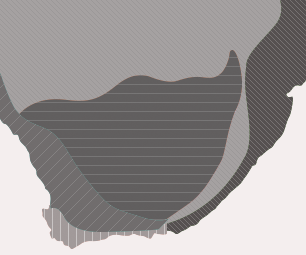Pellaea calomelanos
Pellaea calomelanos (Sw.) Link
Family: Pteridaceae
Common names: hard fern (Eng.); inkomankomo (isiZulu); lehorometso (Sotho); legogoana (Tswana)
Introduction
This attractive plant is widespread in the summer-rainfall areas of South Africa and is the most common fern in Gauteng. It occurs throughout the country.

Description
Description
The hard fern is very leathery in texture, with bipinnate fronds [= leaves of a fern; bipinnate = divided into primary divisions (pinnas) which are again divided into secondary divisions (pinnules)]). They are 160-200 mm long and remarkable for a general lack of protective hairs. The rigid, blue-green fronds are up to 350 mm long and are held erect on strong, shining black stipes (= petioles or leaf stalks of a fern).

This distinctive and common fern has a short, creeping underground rootstock about 6 mm in diameter, covered with small brown scales. The firm-textured pinnules have a distinct line of brown spore-producing bodies (sori) along the edges.
Conservation Status
Status
P. calomelanos is listed on the Red List of South African plants 2009 as Least Concern. A taxon is Least Concern when it has been evaluated against the five IUCN (International Union for the Conservation of Nature) criteria and does not qualify for the categories Critically Endangered, Endangered, Vulnerable and Near Threatened, or the South African categories Critically Rare, Rare or Declining. Widespread and abundant taxa are typically listed as Least Concern.
Distribution and habitat
Distribution description
P. calomelanos occurs over large parts of southern Africa, from the Eastern Cape, Free State, Gauteng, KwaZulu-Natal, Limpopo, Mpumalanga, Northern Cape, North West and the Western Cape. It is also widespread in parts of tropical Africa and on islands in the Indian Ocean. The species can be found on many hillsides where it usually grows at the base of rocks and often manages to survive in tiny pockets of soil in the crevices. It can withstand seasonal droughts remarkably well and is therefore found even in exceptionally dry places. The species adapts well to exposed conditions.
Derivation of name and historical aspects
History
The genus name Pellaea is derived from the Greek word pellos, dark, in allusion to the stalks of this fern which are generally dark. The Greek calos means beautiful and melanos means black.
Ecology
Ecology
The spores of ferns are distributed by air and can travel over long distances. For this reason many species are widespread and occupy similar habitats in different countries, thus reducing the percentage of endemics in a given region.

Propagate through division or from spores. Cultivation of the hard fern is difficult, as only the tiniest of plants will transplant. Never try to move it once it is established in your garden.
Uses
Use
Burnt leaves are smoked for headaches, chest colds, asthma and head colds. Decoctions of rhizomes are traditionally used to treat boils, mouth or nasal ulcers and intestinal parasites. Boiled roots and rhizomes are used as poultices for abscesses, while milk decoctions of rhizomes are administered to frightened children at night and for internal sores. Tea made from this species was an early Cape remedy for colds and chest ailments.
Growing Pellaea calomelanos
Grow
It is important to sterilize the germination mixture before sowing the fern spores by pouring boiling water over it. This kills the spores of fungi and other plants that may germinate and crowd out the developing fern prothalli.
Spores should be sparsely sprinkled on a medium such as peat moss. Equal parts of loam and peat moss spread to a depth of 2cm over a base of vermiculite also forms an excellent germination base.
Once sown, the containers should be covered with plastic or glass (allowing some airspace) and kept at around 20 degrees C in indirect light. Spores take from 2 to 6 weeks to germinate.
References
- Hancock, F.D., Lucas, A. 1973. Ferns of the Witwatersrand. Witwatersrand University Press, Johannesburg.
- Roberts, M. 1990. Indigenous healing plants. Southern Book Publishers.
- Van Wyk, B.E., Van Oudtshoorn, B., Gericke, N. 1997. Medicinal plants of South Africa. Briza Publications, Pretoria.
- Hutchings, A., Scott, A.H., Lewis, G. & Cunningham, A.B. 1996. Zulu medicinal plants: an inventory. University of Natal Press, Pietermaritzburg.
Credits
Mandisa Kondlo
Walter Sisulu National Botanical Garden
June 2012
Plant Attributes:
Plant Type: Fern
SA Distribution: Eastern Cape, Free State, Gauteng, KwaZulu-Natal, Limpopo, Mpumalanga, North West, Northern Cape, Western Cape
Soil type: Loam
Flowering season:
PH: Neutral
Flower colour:
Aspect: Full Sun
Gardening skill: Challenging
Special Features:
Horticultural zones











Rate this article
Article well written and informative
Rate this plant
Is this an interesting plant?
Login to add your Comment
Back to topNot registered yet? Click here to register.